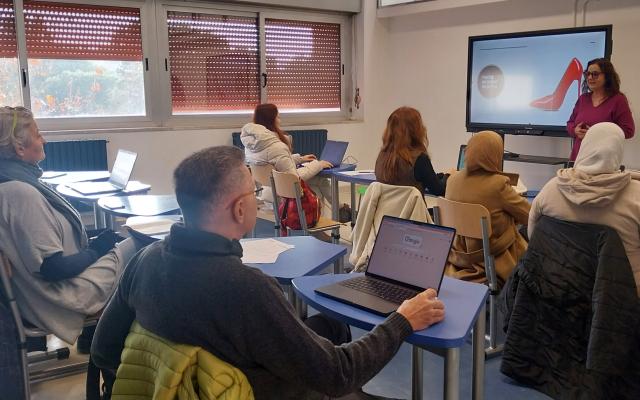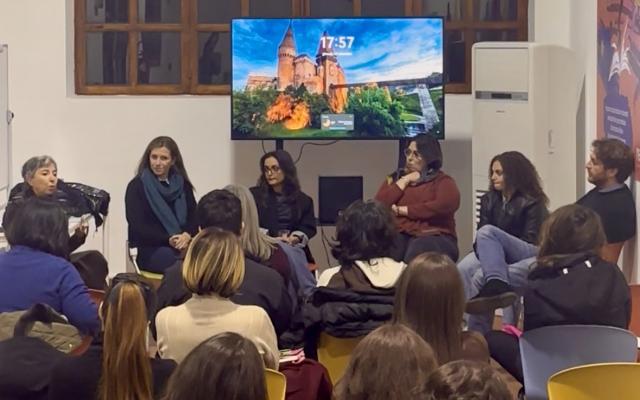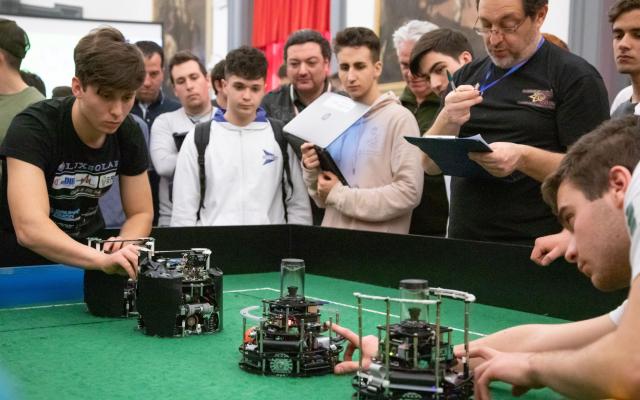Days, competition fields, regulations and finals
They overcome obstacles, locate light sources, kick a ball and do pirouettes, but they cannot do without "bolts and screws." They are the robots built and programmed by students participating in RomeCup 2023, the multi-event dedicated to robotics, artificial intelligence, and life sciences.
International City of Rome Robotics Trophy
The sixteenth edition will welcome 124 teams from 31 Italian schools. The competition categories are Rescue Line (primary/secondary), Rescue Simulation, On Stage, Soccer (Open league and Light weight league), Explorer Junior, Explorer Senior.
RoboCup Junior 2023
RomeCup will host the national selections for the RoboCup World Robotics Championships that will be held on July 4- 10 at the Parc des Expositions in Bordeaux. The categories are: Soccer Open League, Soccer Light Weight, Rescue Simulation.
World Robot Olympiad Italia
The competition categories for the sixth edition are RoboMission and Future Innovators. For further information: worldrobotolympiad.it
WHERE AND WHEN
INITIAL PHASES: May 3-4, 2023, Rome Campus Bio-Medico University
FINALS AND AWARDS CEREMONY: May 5, 2023, Sala della Protomoteca, Rome Campidoglio
SOCCER
Soccer robots play autonomously (i.e., without being remotely controlled) and perform dribbles, passes and goals, thanks to a special ball capable of emitting infrared rays. The match takes place over two 10-minute halves with a 5-minute break. To locate the ball (RoboSoccer Ball) the robots use special sensors and, in order to avoid collisions between the walls of the fields and amongst robots, they emit ultrasonic pulses and calculate the return time of the pulse to determine the distance of any possible obstacle. An electronic compass provides the on-board computer with the orientation of the robot for navigation purposes and to avoid any own goals. Some robots are equipped with mechanical and pneumatic mechanisms for holding and kicking the ball. The playing field, a green carpet on a hard surface, measures 122 x 183 cm. The robots in the Lightweight League category are the same size as in the Open League (max 22 cm in height and diameter) but are lighter, 1100 g instead of 2400 g and less "powerful" (12 V instead of 15 V batteries). The Open category is played with a "passive" orange ball, while the Light Category employs a ball active with infrared radiation (IR).
[https://robocupjuniortc.github.io/soccer-rules/master/rules.pdf]
RESCUE LINE
These robots are programmed to intervene in emergency situations, from earthquakes to terrorist attacks. They move through rubble, climb stairs and, thanks to special sensors, can identify victims. Rescue Robots can support men in the most complex rescue operations. In the competitions, the field is made up of modular tiles (30cm x 30cm), which can be used to make an infinite number of courses. The layout will not be revealed until the race day. The competition field may either be smooth or fabric (linoleum or carpet) and have steps up to 3 mm in height. The environmental conditions in a tournament can vary, as can the lighting. The playing field can also be affected by magnetic fields. The path to follow is a black line drawn on the competition field. Along the way, the robots encounter various obstacles, debris, bumps, etc. which they must overcome in order to locate and reach the victim to be rescued. Each team has 8 minutes to complete the course. The course is considered complete when the robot leaves the evacuation area after a successful rescue and exits the site.
[https://junior.robocup.org/wp-content/uploads/2023/01/RCJRescueLine2023…]
RESCUE SIMULATION
In an emergency scenario, where men cannot intervene without putting their lives at risk, it is necessary to organize a rescue team made up of robots to carry out their mission autonomously. The robot has to be strong and smart because it has to move in a treacherous terrain, full of obstacles. When the robot finds the victim, it must save them by transporting them to the safest evacuation point and entrust them to the care of men. Teams must develop strategies and programmes that enable robots to act in both real-world and virtual rescue scenarios. Participants compete in teams of 2-6 people. Each member has a specific technical role. The category is open to students aged 11 to 19. Time management and technical skills are essential.
[https://junior.robocup.org/wp-content/uploads/2023/02/RCJRescueSimulati…]
EXPLORER
Mini robots are programmed to move autonomously in search of light sources placed in both fixed and unknown positions on a competition field, which is presented to the participants 10 minutes before the competition. They must avoid obstacles, identify the position of lights (junior explorer), gas or sounds (senior explorer) and signal their presence by emitting a light or acoustic signal. The perimeter of the competition field is delimited by a 300 mm high white border. Inside the field, there are white parallelepiped-shaped obstacles (400 x 220 x 300 mm). Obstacles may be arranged to form corridors no less than 300mm wide. The edges of the competition field are also considered obstacles to all intents and purposes. The junior and senior competitions are divided into several tests, established by the jury, lasting approximately 3 minutes each.
ON STAGE
Teams are invited to design, build, and programme robots to perform creatively, either by dancing or acting. They are encouraged to be creative and innovative both in the design of the robots (using multiple technologies) and in the development of the whole performance, in order to attract and engage the audience. Team members can perform with their robots on stage during the performance, which can last up to two minutes. The teams are evaluated on several aspects: a Technical Description Document (TPD), a technical demonstration and interview, and a stage performance.
[https://junior.robocup.org/wp-content/uploads/2023/01/OnStage-Rules-202…]
REGULATIONS
are made to the regulations of the various categories every year to improve the quality of the competitions. For information on the competition methods, field characteristics, and robot configuration, please consult the updated regulations on the official website: junior.robocup.org
NAO ROBOT EXHIBITION
NAO robots, produced by Aldebaran Robot, are about half a meter tall and have legs, arms, hands, sensors and interactive capabilities. It is an extremely realistic robot, which has very natural and expressive postures. Every movement is controlled by the "computer" brain, the efficient processor located in its head. The robot has 25 degrees of freedom and is well equipped with sensors: buttons on its feet, ultrasound on its chest, omnidirectional microphones in its ears, cameras, etc. They are autonomous and programmable, and feature a five-axis inertial centre, sensors and an advanced multimedia system. NAOs can grab objects, move around, dance, explore a room, and even interact with people. The football exhibition organized by the “A. Ruberti” Department of Computer, Automation and Management Engineering at Sapienza University of Rome always leaves the audience breathless. Even the children can try their hand at the penalty kicks and the NAO goalies dives with great naturalness and readiness to save any shots. This year, the performance is at risk, because the players have been injured, just like in real teams!



